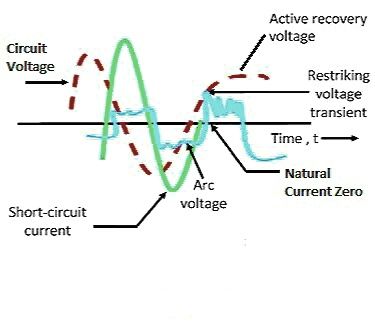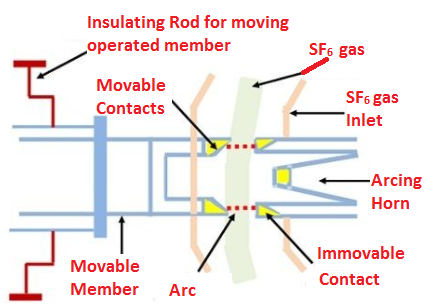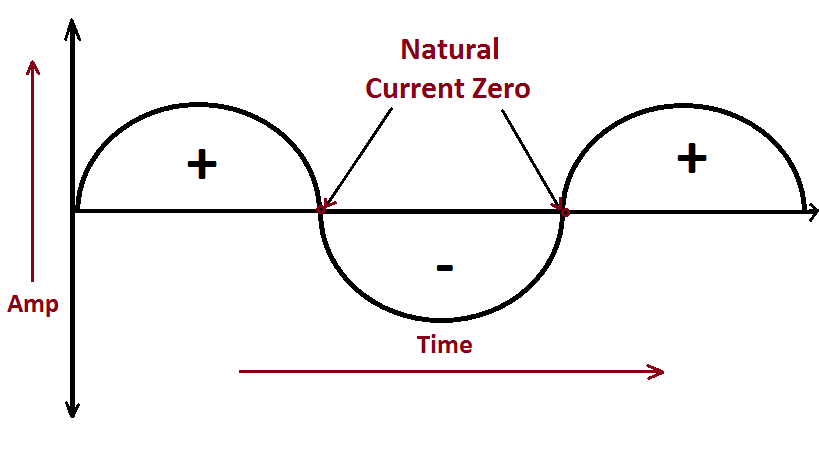Principle and Challenges of Arc Extinction in Circuit Breakers and Possible Remedies
The high level of interconnection and the increasing capacity of generating stations warrants that protective devices and switchgear are reliable and can operate at an optimum level to avert the incidence and harmful effects of faults. In the event of occurrence of short circuits, an enormous power can be supplied to the fault with resultant damage and interruption of service.

The protective device aims to achieve:
- Complete reliability
- Absolute certain discrimination
- Quick operation and
- Non-interference with future extensions
Principles of Arc Extinguishing
The circuit breaker isolates the faulty section of the power system upon getting signal from the protective relays that there is an abnormal condition. The circuit breaker progresses to open its contacts. At the instant when the contacts of a circuit-breaker begin to part there is a large current (several hundreds of thousands of amperes) and a small voltage drop.
A slight separation of the contacts does not result in an immediate cessation of the current because as the contacts separate, the resistance between them increases and as such the ohmic loss (I2R), generates sufficient heat to ionise the air or vaporise and ionise the oil. The ionised air or oil vapour acts as a conductor because of a large number of free electrons present and the current flows without immediate change across the arc which has been formed. The potential drop between the contacts is sufficient to maintain the arc and is quite small.
Separating the contacts draws the arc out, but it is not practicable to extend the arc to such a length that the voltage available will not be able to sustain the arc. This reasoning is because, in a high voltage system, the separation that will result in the extinguishing of the arc will require a separation of several yards to achieve this result.
The conductance (the inverse of resistance) of the arc is proportional to the number of electrons per cm3 produced by the ionisation, the square of the diameter of the arc, and the reciprocal of the length. Like we said before, we cannot do much by increasing the length of the arc to any reasonable value.
The best practice is to decrease the density of the free electrons, i.e. reduce the ionisation and decrease the diameter of the arc.
The purpose of arc extinction in a d.c circuit is more prolonged than in a.c circuit, and we will highlight the reason subsequently.
Free electrons are produced in an arc in two main ways:
- By thermal ionisation, that is ionisation by collision of the atoms due to thermal agitation
- By ionisation by bombardment of electrons which attain high speeds under the electrostatic field.
We can remove the free electron from the arc in two main ways:
- By recombination of electrons and positive ions
- By diffusion of electrons out of the arc
Under steady state conditions, production of arc equates the removal of the arc.
To extinguish the arc, we need to decrease the thermal ionisation which yields more conducting electrons and bombardment of electrons which results in speeding of electrons that culminates in knocking off electrons from neutral molecules thereby releasing more free electrons for conduction.
The way out is to make sure that the rate of electron recombination and diffusion is higher than the ionisation of air which results in more electrons.

We can achieve this by cooling the arc.
Methods of Arc Extinction
There are two methods of extinguishing an arc:
- High resistance method: This method involves controlling the arc to increase the effective resistance with time. We all know that increase in resistance reduces the current and if this reduction in current is progressive, the heat generated by the current will dwindle accordingly until it is no longer able to sustain the arc. The result is that the arc will be extinguished. The rate at which the resistance is increased or the current is reduced could generate energy in the form of heat that could be disastrous which may result in explosive forces. Due to the resistive nature of the arc discharge, almost all the energy in the system will be dissipated within the circuit breaker.
It is therefore imperative while designing the circuit breaker to make provision for adequate mechanical strength to absorb the sudden discharge of large quantities of energy. This discharge is one of the disadvantages of this system, and that is the reason this method is limited to dc circuit breakers and air break circuit breakers that is usually of low capacity. It is noteworthy to remember that the interruption of dc arc is relatively more difficult than equivalent ac arc because of the absence of current zero in dc. During the regular wave of ac, there is natural current zero, and as such when the current reaches its zero position, the arc is automatically extinguished, and the voltage between the contacts is zero.
There are several methods of increasing the resistance of the arc, and they include:
- Cooling of the arc: When you cool the arc, the rate of recombination of the electron and positive ion is increased.
- Increasing the length of the arc: As we stressed earlier, if the distance of separation of the contact is limitless, there will get to a point when the arc voltage will be insufficient to maintain the arc. But the limit of separation for practical voltage level is small, and this method may fail as the voltage level increases.
- Reducing the cross-section of the arc: This method can be effected by having a small area of contact or by channelling the arc through a narrow opening. As the cross-sectional area of the arc reduces, the resistances follows it and as such the voltage necessary to sustain the arc will increase.
- Splitting the arc- By introduction of conducting plates in the line of the arc, the arc is split into some small arcs in series and thus experiences lengthening and cooling.
- Low resistance or Current zero interruption: This method is exclusive to ac circuits because of its natural current zero which appears 100 times in a second for a 50 Hz supply system obtainable here in Nigeria.
This method exploits the properties of a.c circuit and maintains the arc resistance at a low level while awaiting the natural current zero where the arc extinguishes naturally and is prevented from restriking after leaving the current zero position.

The voltage then increases in the reverse direction and will soon approach a value which is sufficient to restrike the arc.But during the period of inactivity (current zero), a certain level of recombination of ions and cooling takes place, so that the restriking voltage is somewhat higher than the voltage previously required for the maintenance of the arc.
This recombination continues for several cycles, at the end of which period sufficient recombination of ions and cooling has taken place for the circuit voltage to be insufficiently large to restrike the arc. The arc is then extinct, the circuit current is zero, and the circuit voltage recovers and increases finally to its normal value.
The recovery voltage is somewhat lower than the normal circuit voltage because of armature reaction (weakening of the flux reduces the recovery voltage).
Conclusion
Air offers the majority of insulation in the electrical power system. Since there is no perfect insulator, it, therefore, becomes imperative to know the breakdown strength of any insulation being used and the kind of voltage stress it can withstand for a specific duration. Ionisation of air starts at the breakdown strength of 30KV/m. Above this value, if the voltage stress is maintained the electrons inherent in the air will speed up to knock out more electrons in the molecules of air bringing into existence more electrons which will if unchecked will lead to an avalanche of electrons. This phenomenon is called Townsend effect, and at this point the ionisation is complete and the ensuing arc sustained.
There is also thermal ionisation which is ionisation by the collision of atoms as a result of agitation.
This ionisation of air is very important especially during the opening of contacts of the circuit breaker. We are aware that circuit breaker is an essential protective system which comes at a high cost and as result care should be taken in safeguarding it during its normal operation.
One of the problems encountered during the operation of a circuit breaker is in the separation of its contacts. This separation of contact is necessary if it must perform its duty as a protective device. The opening of its contacts gives rise to the ionisation of the air between the contacts of the circuit breaker which results in arcing; Therefore, means must be provided to quench the arc to avoid possible explosion or destruction of the circuit breaker contacts.
This arc extinction is vital to avoid replacing the contacts of the circuit breaker every now and then. The different methods of arc extinction were discussed, and the specific condition preferable for each situation elaborated.
The ability to remove the arc speedily from the system is paramount because sustained arc can erode the contacts leading to excessive heat and eventual breakdown of the the circuit breaker. This is undesirable as it would not only lead to power interruption but waste of manpower time, energy with regards to replacement but the cost of circuit breaker replacement is somewhat high. Once gain, you deliver it with clarity .Wonderful pictorial description, I must say. Looking up to see more of it in the coming days. Kudos.
I am thrilled the post made some impact on you. Power system protection is like an insurance of the power system equipment and as such should be designed properly to avoid loss of life and investment. Thanks for your time and comment. i deeply appreciate it.
A well organised post as always. You explanation about the difficulty in extinguishing a dc arc is quite lucid and understandable because of the absence of current zero in dc quite unlike in ac where the current goes through natural current zero. This natural current zero helps in allowing a time lapse necessary for recombination of ions and this makes the restriking voltage somewhat higher than the what would have been needed in the absence of natural current. As a result after few cycles, the arc dies off.
Thanks for keeping up to your reputation in delivery a quality content. I wish I could post of just one particular thing the way you do. Well done :)
Thanks for your time and input.
You're welcome :)